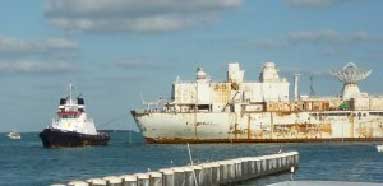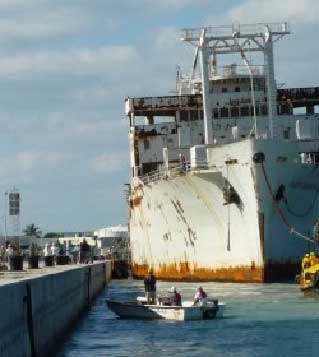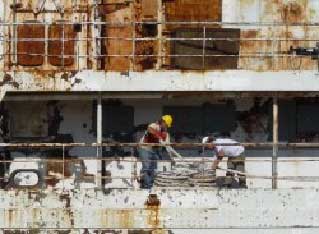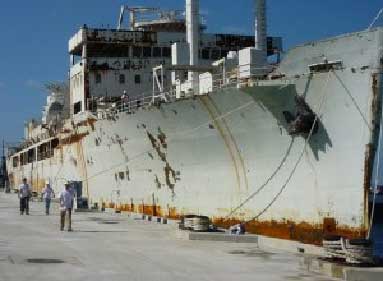The Gen. Hoyt S. Vandenberg
 While all the ship-visiting and garden-gawking were going on - and after ten years and $12 million had been expended in the effort - the enormous troop transport Vandenberg (originally commissioned as the U.S.N.S. General Harry Taylor) was on her way south, under tow from Norfolk VA to Key West. We tracked her progress all week via the tug captain's updates at the Big Shipwrecks website:
While all the ship-visiting and garden-gawking were going on - and after ten years and $12 million had been expended in the effort - the enormous troop transport Vandenberg (originally commissioned as the U.S.N.S. General Harry Taylor) was on her way south, under tow from Norfolk VA to Key West. We tracked her progress all week via the tug captain's updates at the Big Shipwrecks website:
April 15, 2009, Capt Billy Notes "All Ok on tug and ship. Weather forecast improving, expect to pick up speed and favorable conditions tomorrow. Will hug coast to avoid Gulf Stream and hope to pick up a nice counter current. Tow behaving well and towing nicely..."
Whoever this Captain Billy was, he was being modest: the deep sea tug Elsbeth III was towing a listing steel shell nearly two football-fields long through the open ocean, averaging four to seven knots in seas ranging from 4' to 20'. We can presume lots of rollers coming in from the Atlantic and giving the two boats a continuous and ( in my experience) nauseating side-to-side roll.
 We tracked her progress on the web and checked in with the Mohawk volunteers every now and then. Vandenberg's arrival would depend on the progress of the tow but she was finally slated to enter the harbor on Wednesday, April 22. As she drew near there were issues:
We tracked her progress on the web and checked in with the Mohawk volunteers every now and then. Vandenberg's arrival would depend on the progress of the tow but she was finally slated to enter the harbor on Wednesday, April 22. As she drew near there were issues:
The Coast Guard insisted (wisely) that no cruise ships be in port while the Vandenberg was being maneuvered into position (their sterns generally jut well into the harbor mouth) and the city of Key West is loath to miss out on the $20,000 tithe it receives from each cruise ship coming to port. So as the tow drew nearer the lower Keys, it became apparent that Wednesday would be the only day on which no cruise ships were scheduled.
Thank goodness the weather cooperated and it was as calm as it could be. The tug aimed to arrive at slack tide - one less thing to contend with while maneuvering a 500'+ sliding steel battering ram into place (Vandenberg is 522' long, 76' wide in the beam and dragging 25' draft below waterline - not to mention her superstructure catching the winds above).
Rick and I checked our tide charts and so got up early and peddaled our bikes to the Harbor. As soon as we neared Mallory Square we could see an enormous white structure out in the ship channel - the Vandenberg's superstructure was visible for miles.
 Soon we discerned the tow party: Elsbeth III was towing the ship with an enormous (2-1/2" diameter) steel cable connected to the Vandenberg's own anchor chain. By then other professionals were assisting: the tug Broward's tow cable was attached to her stern (second photo, above right). The tugs Ocean Atlas and Ocean Wind kept pace along her port and starboard sides. Dozens of Coast Guard, Police, TowBoatUS, harbor pilot and line handlers' boats loitered nearby and a helicopter circled continuously overhead.
Soon we discerned the tow party: Elsbeth III was towing the ship with an enormous (2-1/2" diameter) steel cable connected to the Vandenberg's own anchor chain. By then other professionals were assisting: the tug Broward's tow cable was attached to her stern (second photo, above right). The tugs Ocean Atlas and Ocean Wind kept pace along her port and starboard sides. Dozens of Coast Guard, Police, TowBoatUS, harbor pilot and line handlers' boats loitered nearby and a helicopter circled continuously overhead.
We saw the party inch slowly past and beyond the harbor mouth and then Broward at the stern reversed and slowed. Then, with both tugs keeping continuous tension on the tow cables, Broward began to pull the Vandenberg backwards into the harbor while Elsbeth III kept constant tension on the bow cable.
Harbor depths are 31' to 33' deep. Even so, turbulence from the tugs' multiple propellers churned the bottom silt into soup.
Broward slowly dragged Vandenberg stern-first into the harbor. By then Ocean Atlas and Ocean Wind were nose-to her port side fore and aft and they pushed laterally. All cables remained taut and waves from the props continuously churned against the seawall.
 Inch by inch the Vandenberg slid sideways into her slip (photo left). We didn't hear a sound as she eased up against the enormous Navy fenders along the sea wall.
Inch by inch the Vandenberg slid sideways into her slip (photo left). We didn't hear a sound as she eased up against the enormous Navy fenders along the sea wall.
The harbor crews really scurried into action then, as men in boats ferried the enormous dock lines to teams ashore - see the docking process for huge ships in Key West The Travelogue. The lines were made fast to pairs of huge bollards both aboard (below right) and ashore (below left). All tugs remained in place, engines running and lines taut, throughout the procedure. Soon the shore crew had to double up to tighten the dock lines and it took several men all pulling together to hoist the lines and bring in the slack.
It is impossible for photos to illustrate the size of this vessel, literally. She was too huge to fit both tugs and the Vandenberg into one frame. She is a fifty-two story building lying on her side and her windage above the waterline looks to be at least eight stories high. She is overwhelming.
So here she is: safely ashore for the time being. If we didn't tell you before, she will be sunk offshore to create the second-largest man-made reef. I had thought, "Cool. But, why?" and so when we met an oceanography professor from Florida Keys Community College - one of the supporters of the Vandenberg Artificial Reef Project - we asked that very question. He informed us that the ship is a huge money-maker for the community because divers find it so fascinating. And this is critical because it significantly reduces pressure on the reefs which are in big trouble these days. So you gotta love that.
 Go to Big Shipwrecks.com for history, updates, photos and more info on the project. Another official we met told us they've been too swamped to really perfect the website but they will keep working on it. It's pretty informative as-is, check it out.
Go to Big Shipwrecks.com for history, updates, photos and more info on the project. Another official we met told us they've been too swamped to really perfect the website but they will keep working on it. It's pretty informative as-is, check it out.
Vandenberg will stay in port as long as possible so she can be celebrated and so volunteers of the same-era Mohawk can "requisition" the ship's fittings and steel and other necessities to further their own restoration efforts. Then, in the engineering feat of a lifetime Vandenberg will be towed out and sunk just before hurricane season. We'll all be able to watch it on National Geographic and the Discovery Channel's Mythbusters.
Underwater cinematographer Conrad Eskilinen told us we could catch a previews of the Discovery Channel's films at his site, DiveBum.com. Check it out.
A Tangent
The Vandenberg was awe-inspiring and mind-boggling but, unlike Mohawk, we were haunted by the fact that her very existence is due solely to a world-wide deadly conflict that claimed an enormous toll in lives lost. For that reason we found ourselves sobered in her presence, and conflicted: as we raved about how amazing and cool the ship is and how REALLY cool are the logistics of the project and the engineering of the upcoming scuttling, we would not ignore her history and we found ourselves lowering our voices respectfully as though we were present at a memorial to the lost.
But we had no such reservations about the tug: she went straight to our hearts. Elsbeth III was the highlight of that day for Rick and me.
Key West's newspaper The Citizen is useful in its way. But as far as I know Boathooked.com scooped them with our exclusive coverage of the deep sea tug Elsbeth III and interview with Captain Billy. Bwa-ha-ha-ha-ha.
Elsbeth III
 As we loitered outside the safety barricades watching crews struggle with Vandenberg's weighty dock lines, city V.I.P.s glad-handed voters and ate donuts on the Mohawk. Relieved 'Reef Project' members mopped their brows and laughed in sheer adrenelin overload, project planners granted interviews to DiveBum.com and local news, and dockhands took photos of the behemoth with their cell phones.
As we loitered outside the safety barricades watching crews struggle with Vandenberg's weighty dock lines, city V.I.P.s glad-handed voters and ate donuts on the Mohawk. Relieved 'Reef Project' members mopped their brows and laughed in sheer adrenelin overload, project planners granted interviews to DiveBum.com and local news, and dockhands took photos of the behemoth with their cell phones.
Meanwhile, forward of the big ship, Elsbeth III sat quietly secured to the seawall, her winch still taut with Vandenberg's anchor chain. Crewmembers in safety-yellow Tshirts and hardhats worked efficiently and then dispersed. Aloft, a young man with crew cut, shoulder-to-elbow tattoos and mirror shades leaned out from the bridge, arms crossed casually on the railing, below.
Rick and I were fascinated by the working tug. She is one of four tugs owned and operated by Smith Maritime - Ocean Towing & Salvage Services. Her owner, Latham Smith, designed and built each tug in the fleet. A spry gentleman I saw flitting around Vandenberg's top decks later proved to be Mr. Smith.
By now the crew-cut and sunglasses man was ashore and talking with a woman holding a dog in her arms. What the heck. So I introduced myself to thank them for their work and to acknowledge what appeared to be a technical and delicate maneuver at the end of a couple of probably long and tiring weeks.
The man introduced the pretty woman as Mrs. Smith, wife of the tug's designer. And he introduced himself as captain of the Elsbeth III.
Captain Billy? Holy cow! I shook his hand. "We've been following your dispatches all week, what an amazing experience it's been. And you have the coolest boat."
Capt. Billy was modest and articulate, and before I knew it he had invited us aboard for a tour.
Needless to say, Capt. Billy and Rick went directly to the engine room while I enjoyed a brief chat with Mrs. Smith. She and I compared author Farley Mowat's seafaring books in which I had learned to revere tugs, and we had both enjoyed the lesser-known Mowats (Grey Seas Under and Serpent's Coil - both books are excellent edge-of-your-seat depictions of deep sea tugs' Atlantic and Carribean salvages and rescues - and The Boat Who Wouldn't Float which is just purely delight).
Well. Eventually I caught up with Rick and Capt. Billy descending from the pilot house. Billy showed us the quarters where he and his wife live. She has her captain's license as well so they are able to be together, doing work they love.
Capt. Billy grew into the life: his father and grandfather worked on tugs so he felt it was a natural path to take - he is clearly a dedicated and skilled individual to have attained his position of responsibility. His favorite part of the job: waking up each day on the sea and doing what he loves.
Capt. Billy agreed that, other than in obvious matters of technology and communications, deep sea salvage and maritime law haven't changed much in 200 years. "It's the last form of legal piracy," he nodded. Emphasis on legal.
A tug boat's duties are historic: rescuing crews, towing injured vessels to port, and performing rescue and technical assists to ships in hazardous conditions:
In 1975 major recognition came from the international community when the Epic Colotronis was burning and sinking in Mona Passage. Elsbeth, Capt. Smith commanding, was the only vessel to approach and put men on board; they found the ship was deliberately being scuttled [sunk] with 56,000 tons of crude on board. Elsbeth and crew were able to secure hatches and doors that were open to the sea taking water, and turned the bow to wind, minimizing the spread of fire, danger of explosion and entrance of water. The ship was towed in safely by Smit International Salvage, who arrived two days later.
Imagine seas heavy enough to pour water into the hatches and doors of a huge tanker. The tanker's bulworks were undoubtedly much higher than the tug's, so try to imagine boarding a looming, heaving, unfamiliar and burning tanker. We can assume that the power is out and water is pouring in so it is dark and slippery AND on fire. And now imagine locating and solving problems, receiving and attaching a tow line deployed by your tiny tossing vessel, and staying with the burning ship for two days. And loving it.
Elsbeth III is outfitted for a range of thirty days towing and sixty days utility work, and their equipment includes a "rescue launch". Rick learned from Capt. Billy that the entire crew are certified divers.
Under maritime law (don't quote me, by which I mean don't try to nab a boat on my say-so) when a ship has been abandoned, or when a distressed ship's owner agrees to specific legal provisions, the assisting vessel which gets a line on her has salvage rights. As the old time Key West wreckers learned, this may mean a great deal of money from the ship's underwriters who would otherwise be at a loss for the entire vessel and its contents. Therefore, Smith Maritime stations her four tugs at various points around the Atlantic and Carribean. When a distress call comes in it's a race to the scene. Just as in the old days.
Check Smith Maritime's website for information on all of their ships, it's pretty amazing. For example, you'll be agog when you learn that Elsbeth III's three 12-cylinder diesel engines produce 5000 horsepower and her bow thruster is 100 hp (Sea Gator's entire engine is 135 hp, woo!). She has three separate props which can rotate independently, which explains the slick maneuvering against Key West's seawall. She is a tidy 90' working ship, in the tradition of her forebears.
Elsbeth III's next assignment will take her to Africa. It's all in a day's work for Capt. Billy. He smiles at the thought of crossing the Atlantic again.
Captain Latham Smith arrived aboard with lots of work to do no doubt, so Rick and I shook Capt. Billy's hand and wished him a safe voyage, thanked them both and took ourselves away.
What an incredible experience, to have walked in the living footsteps (to mix several metaphors) of such a noble profession, and to honor living history in the able person of Capt. Billy. This was the highlight of our trip. After the Mohawk. No, before the Mohawk. No, wait

 Smith Maritime's vessels operate primarily between the U.S., the Caribbean & South America. More recently to several ports in Europe, the Mediterranean Sea & Pacific Northwest. Our history is one of dedicated service with a superior loss record. Our services include ocean and coastal towing, pipe & cable laying, submersible operations, cargo & dredge ops, demolition, harbor, anchor and buoy handling, and most exciting of all, salvage and rescue.
Smith Maritime's vessels operate primarily between the U.S., the Caribbean & South America. More recently to several ports in Europe, the Mediterranean Sea & Pacific Northwest. Our history is one of dedicated service with a superior loss record. Our services include ocean and coastal towing, pipe & cable laying, submersible operations, cargo & dredge ops, demolition, harbor, anchor and buoy handling, and most exciting of all, salvage and rescue.